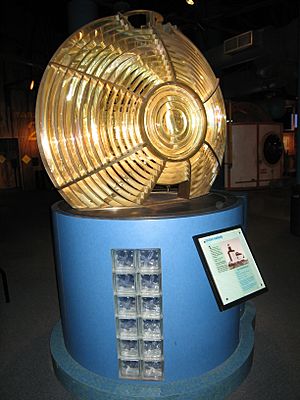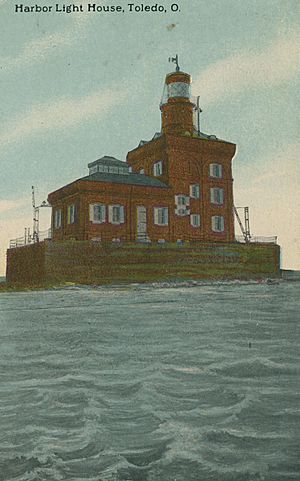Toledo Harbor Light facts for kids
 |
|
| Toledo Harbor Lighthouse | |
|
|
|
| Location | Toledo Harbor, Jerusalem Township, Lucas County, Ohio |
|---|---|
| Coordinates | 41°45′42″N 83°19′42″W / 41.76167°N 83.32833°W |
| Year first constructed | 1901 |
| Year first lit | 1904 |
| Automated | 1965 |
| Deactivated | N/A |
| Foundation | Stone and concrete pier on crib |
| Construction | Buff brick and steel three-story keeper's dwelling with attached fog signal building. |
| Tower shape | Frustum of a cone on top of square Romanesque dwelling with attached fog signal building |
| Markings / pattern | natural, black roof, lantern and parapet |
| Height | 69 feet (21 m) |
| Focal height | 72 feet (22 m) |
| Original lens | 3½-order Fresnel lens (1904) |
| Range | 10 nautical miles (19 km; 12 mi) |
| Characteristic | isophase W 6 s
HORN: 1 blast every 30 s (3 s bl). Operates from April 1 to Dec. 1. |
| ARLHS number | USA-853 |
| USCG number | 7-6030 |
The Toledo Harbor Lighthouse is a famous lighthouse located in Lake Erie, near Toledo, Ohio. It helps guide ships safely into the Toledo harbor. This lighthouse is still working today, making sure boats can find their way. It replaced an older lighthouse that was built in 1837 on Turtle Island.
Contents
Toledo Harbor Lighthouse: A Lake Erie Landmark
The Toledo Harbor Lighthouse stands on an artificial island. This island was made from a large stone crib sunk 20 feet deep. The lighthouse is about 8.4 miles from the mouth of the Maumee River. It marks the main entrance to the Toledo harbor. You can find it about 7 miles north of Maumee Bay State Park.
Why Was It Built?
By the late 1800s, more ships were using the Toledo harbor. The shipping channel was made wider and deeper in 1897. This meant a new, bigger lighthouse was needed to guide all the extra boat traffic. So, plans began for the Toledo Harbor Lighthouse.
How It Was Built
Construction started in 1901. The United States Army Corps of Engineers built a large wooden frame, called a crib. They sank this crib and filled it with stone. Then, they added a concrete base on top of the water. This created a strong, artificial island for the lighthouse. Building with cribs was a popular method for lighthouses on the Great Lakes. Other famous lighthouses like White Shoal Light and Stannard Rock Light were built this way.
A Unique Design
Many people think the Toledo Harbor Lighthouse looks like a "gingerbread house." It has a very special design, different from other Great Lakes lighthouses. It is built in the Romanesque style. The lighthouse cost about $152,000 to build, which was a lot of money back then!
The lighthouse has a three-story building made of brick with a steel frame. On top of the building, a cylindrical tower rises 69 feet. The very tip of the lantern vent is 85 feet above the lake. The lantern room at the top is 8.5 feet wide. It has special helical bars that hold the glass panes in place.
The Original Light
The Toledo Harbor Lighthouse first lit up on May 23, 1904. It used a special 3½-order Fresnel lens. This lens was made in Paris by Barbier and Bernard. It had a large 180-degree bull's-eye and two smaller ones. It also had a ruby-red half-cylinder glass. When the lens turned, it would show two white flashes followed by a single red flash. A heavy weight was used to make the lens spin.

The Phantom Keeper
In 1965, the lighthouse became automated. This meant it no longer needed a lighthouse keeper living there. To stop people from damaging the empty lighthouse, the Coast Guard came up with a clever idea. They placed a uniformed mannequin in one of the upper windows!
This mannequin first looked like a man with a mustache. Later, it even got a long blond wig! Many ghost stories about a "phantom lighthouse keeper" at Toledo Harbor actually came from people seeing this mannequin. Even though it doesn't move, some people swear it has waved to them from the window. Signing the mannequin's shirt has become a tradition for new Coast Guard officers stationed in Toledo.
Keeping the Light On
The Toledo Harbor Lighthouse is still an active aid to navigation today. The U.S. Coast Guard still takes care of the light. In 1966, an electric motor was added to turn the lens. This allowed the lighthouse to work without people living there.
In the late 1990s, the original Fresnel lens was removed. It is now on display at the COSI museum in Toledo. A new, smaller light, powered by solar cells, is used instead. Twice a year, U.S. Coast Guardsmen visit the lighthouse to clean and check the light, solar panel, and batteries.
Saving the Lighthouse
The federal government owned the lighthouse until 2006. Then, the Toledo Harbor Lighthouse Society, a non-profit group, took over. They want to protect and restore the lighthouse. They hope to raise about $1.5 million for repairs.
In 2010, they received a grant to fix the windows, doors, and brickwork. They are also working to add solar power and a water treatment system. Once the restoration is finished, four "keepers" will stay at the lighthouse. They will help schedule visits for people to tour this amazing historic building.
The lighthouse's unique look has made it a popular subject for artists. It is also listed on the National Register of Historic Places. This means it is recognized as an important historical site.
Images for kids




